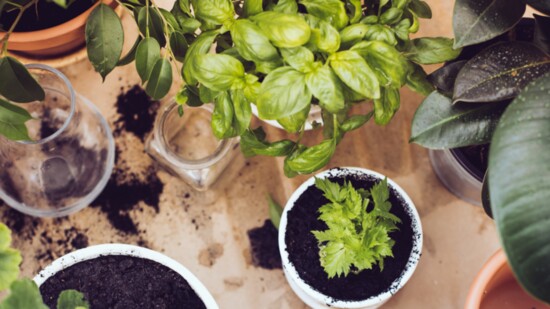Even when the snow is falling, and it’s a winter wonderland outside, a green oasis indoors provides its own special warmth and… lots of veggies!
Herbs, leafy plants, and microgreens are the most common edible plants for indoor growing. They generally do well with shallow soil because they're smaller and don't need as much space inside. They also don't need as much sun and are easier to grow if you're just starting out.
If you're a newbie to gardening, you may want to start small and simple, like a grow kit.
To give your plants the best chance of thriving, you'll want a specific place you can control. Decide if you'll use one room, spread them around the house, or dedicate a windowsill. Also, be aware of your home's humidity, especially during dry winter months, since plants need a moist environment. Plants do best in stable, consistent temperatures in the 60s to 70s with good air circulation to prevent mold or fungus growth.
Generally, a south-facing window will give you the most sunlight, but especially during the winter, you'll need to supplement with grow lamps.
Supplies
Containers should be big enough for your plant's needs. Consider how big the plants will grow, the depth needed for roots, and how far seeds must be planted from each other. When growing plants indoors, you'll also need to think about drainage so excess water doesn't build up and cause problems like root rot or bacterial growth. You don't need fancy, expensive containers, and depending on the plant, you can even repurpose old plastic containers.
The soil you use for growing indoors is different from ordinary garden soil. Use potting mix or soil made explicitly for seedlings and the indoors.
Always check how dry the soil is before watering. Self-watering containers, drip systems, and hydroponic kits that may use pumps are great for making watering easy.
Caring for your garden
Edible plants generally take more effort than just putting seeds in the soil and forgetting them, especially indoors. Each plant has different needs: some may need pruning, adjustments to watering and soil, and various harvesting or replanting times. Keep a journal or binder or a tracking system to keep track of your plants' needs. You can use it to remind you to care for them and how to do so, and track your successes or failures for next time.
In terms of harvesting, some plants need to be picked entirely and then replanted. Other plants, especially herbs and leafy greens, can be harvested as you need while the plant grows and regrows where it was cut.
Finally, remember you can do everything right and still fail, which can be frustrating. But indoor gardening is a learning process, and with a little patience, before you know it, you'll be making delicious dinners from your own indoor garden!
Veggies Great for Growing Indoors:
-
Leafy greens (spinach, kale, lettuce, arugula)
-
Carrots
-
Scallions
-
Potatoes
-
Mushrooms
-
Microgreens (vegetables like beets, radishes, and peas harvested as seedlings or sprouts)
Hearty Indoor Herbs:
-
Mint varieties
-
Cilantro
-
Parsley
-
Basil
-
Rosemary
-
Thyme
-
Lavender
-
Oregano
